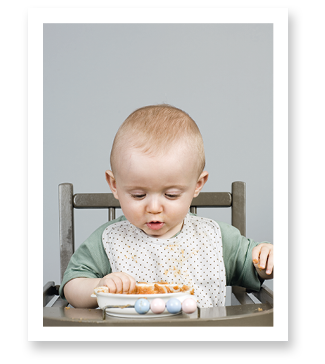


6 months+



Milo, 7 months, tester
Dr. Jean Lalau Keraly,
Pediatric Nutritionist and Endocrinologist
In just a few months, your baby has adjusted to a new diet: Now she eats real portions of vegetables at lunch and some fruit as an afternoon snack, even though milk is still her main food source. She’s becoming more independent, serving herself—more or less skillfully—with her own spoon. In the evening she delights in her bottle of milk sometimes accompanied by a bit of cereal, depending on her appetite.
introduction of new foods
By the age of six or seven months, your baby can take another step on the path to eating like a grown-up: You can introduce meat, fish, cereals, cheese, and other dairy besides milk into her diet. The arrival of these new foods means parents can offer more interesting recipes and elaborate choices. It also means they can begin to mesh Baby’s meals with the family’s, delighting the baby because such a move indicates that her social status in the family has risen. It’s fun for the parents, as well, since it makes for simpler meal logistics.
ever so slowly
If you have introduced meat into the diet of your six- or seven-month-old baby, make sure you don’t turn her into a first-class carnivore! At this age, 2 teaspoons (20 g) a day of animal protein will do for her body. You can serve up to 3 teaspoons at this time, if your baby seems to be a big fan. This is the time to serve your mini-gourmet more elaborate lunches with mixed meat or fish, along with a side dish, so Baby can differentiate the textures, colors, and flavors of the food. The meal naturally ends with a sweet touch—a small serving of fruit compote or crushed fruit—and why not mix in some fromage blanc or plain, unsweetened Greek yogurt?
respect your baby’s appetite, desires, and preferences
If she doesn’t finish eating, don’t force her. If she wants more vegetables, give her some. Unlike we adults, who are capable of serving ourselves three helpings of Aunt Monica’s lasagna—with extra sauce, please, Auntie!—your baby knows how to listen to her body when she’s eaten enough. If she’s no longer hungry, she’ll refuse dessert (even if that seems inconceivable to you). If she doesn’t like the corn compote that you lovingly prepared, don’t take it personally. You can have her try it again some other time. She has the right, just as you do, not to like certain foods, and her tastes will evolve. The simple rule is just to have her taste.
at 7 months
Your baby can start eating eggs. Only serve the egg yolk, however, since the white can be allergenic and is not recommended before a baby is at least a year old (three years old if the child has a history of allergies). Start by offering half of the yolk (well cooked).
at 8 months
You can let your baby chew on a crust of bread, which will help with teething. Always sit next to your little one as she nibbles her bread. If she bites off a piece that’s too big, she won’t be able to spit it out herself. If you’re worried about an accident, try rice cakes instead. They are just as pleasurable for the baby but are safer since the rice grains break off as the child chews.
in this chapter
You are going to discover real lunches that mark a new era of tasty discoveries for your baby. This is the time of flavor association and more complex recipes that are bolder than before. As your baby’s taste buds awaken, you will teach her how to accept and appreciate new things, a talent she will carry late into life. She will not become the kind of person who relies solely on starchy staple foods like rice and pasta.